为通过安全防火墙的站点到站点VPN配置SD-WAN
下载选项
非歧视性语言
此产品的文档集力求使用非歧视性语言。在本文档集中,非歧视性语言是指不隐含针对年龄、残障、性别、种族身份、族群身份、性取向、社会经济地位和交叉性的歧视的语言。由于产品软件的用户界面中使用的硬编码语言、基于 RFP 文档使用的语言或引用的第三方产品使用的语言,文档中可能无法确保完全使用非歧视性语言。 深入了解思科如何使用包容性语言。
关于此翻译
思科采用人工翻译与机器翻译相结合的方式将此文档翻译成不同语言,希望全球的用户都能通过各自的语言得到支持性的内容。 请注意:即使是最好的机器翻译,其准确度也不及专业翻译人员的水平。 Cisco Systems, Inc. 对于翻译的准确性不承担任何责任,并建议您总是参考英文原始文档(已提供链接)。
简介
本文档介绍使用安全防火墙上的SD-WAN功能的BGP重叠路由的基于路由的VPN部署方案。
先决条件
所有集线器和辐条都运行FTD 7.6或更高版本的软件,并通过同样运行7.6或更高版本的软件的FMC进行管理。
要求
Cisco 建议您了解以下主题:
- IKEv2
- 基于路由的VPN
- 虚拟隧道接口(VTI)
- IPsec
- 调试输出中显示“BGP
使用的组件
本文档中的信息基于:
- 思科安全防火墙威胁防御7.7.10
- 思科安全防火墙管理中心7.7.10
本文档中的信息都是基于特定实验室环境中的设备编写的。本文档中使用的所有设备最初均采用原始(默认)配置。如果您的网络处于活动状态,请确保您了解所有命令的潜在影响。
功能信息
通过使用新的SD-WAN向导,管理中心可简化集中式总部(集线器)和远程分支站点(分支)之间的VPN隧道配置和路由。
·通过利用集线器上的DVTI(动态虚拟隧道接口)和分支上的SVTI(静态虚拟隧道接口)实现VPN配置自动化,并通过BGP启用重叠路由。
·自动为分支分配SVTI IP地址并推送完整的VTI配置,包括加密参数。
·在同一向导内提供简单的一步路由配置,为重叠路由启用BGP。
·利用BGP的路由反射器属性实现可扩展的最佳路由。
·允许同时添加多个辐射点,而用户干预最少。
涵盖的拓扑
本文涵盖多个拓扑,以确保用户了解各种部署方案。
集中星型(单个ISP)
网络图
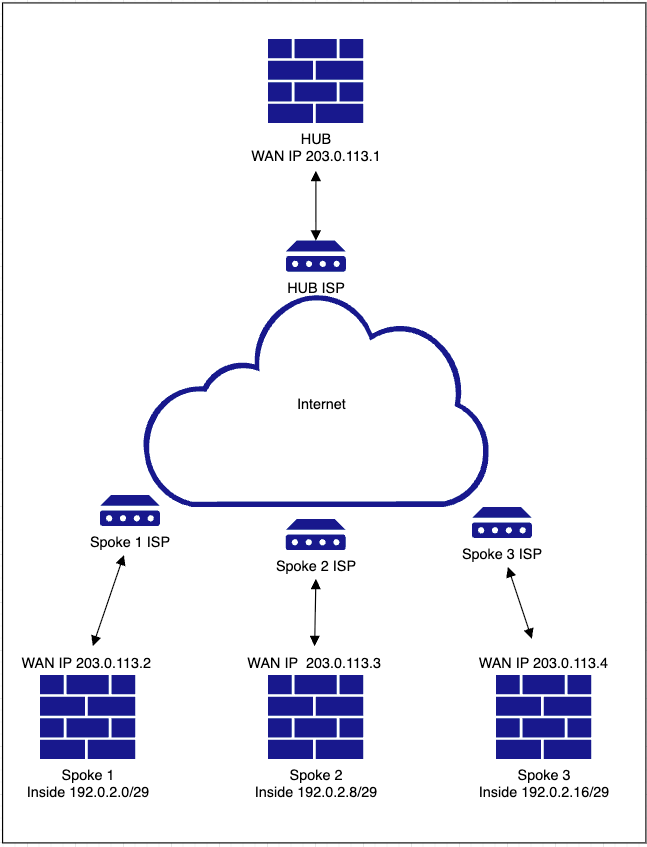
配置
-
导航到设备> VPN >站点到站点>添加> SD-WAN拓扑> >创建。
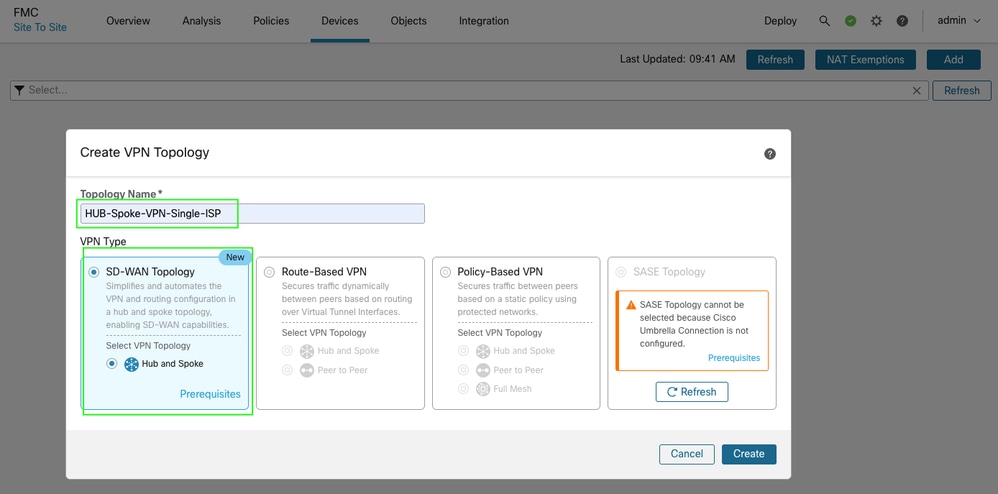
·添加中心并在中心端创建一个DVTI。作为DVTI配置的一部分,请确保根据拓扑选择正确的隧道源接口。
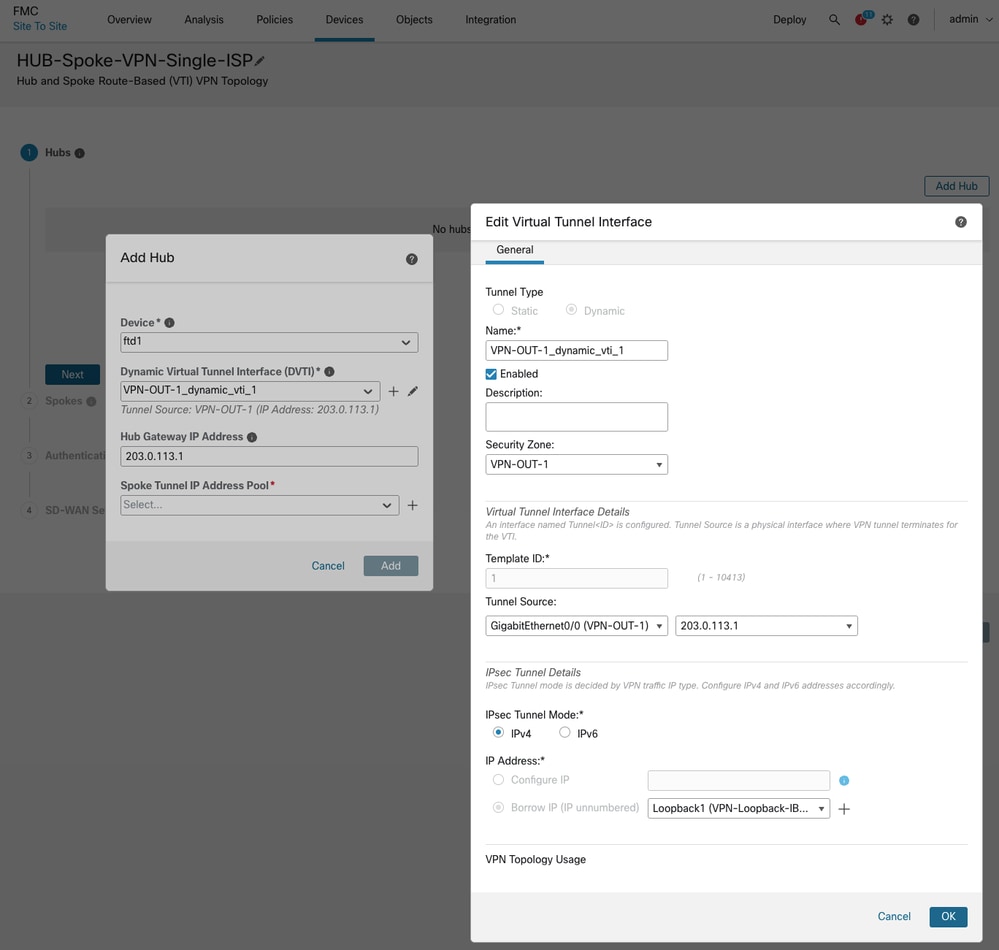
-
创建分支隧道IP地址池,然后单击保存,然后单击添加。ip地址池用于将VTI隧道IP地址分配给分支。
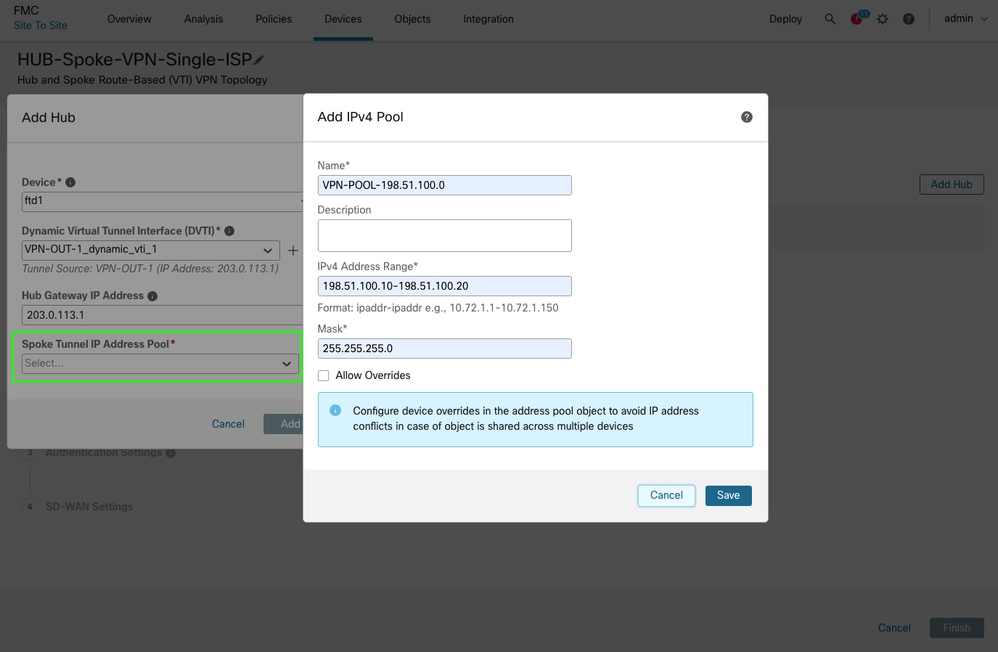
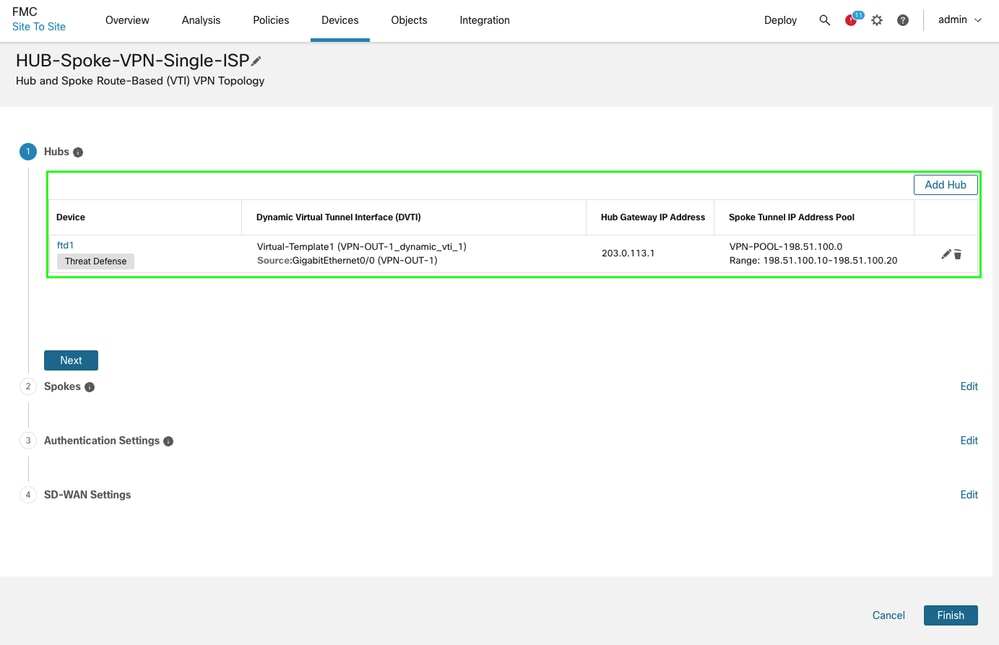
-
单击下一步继续并添加辐条。如果您有通用接口/区域名称,则可以利用批量添加选项,也可以单独添加辐条。
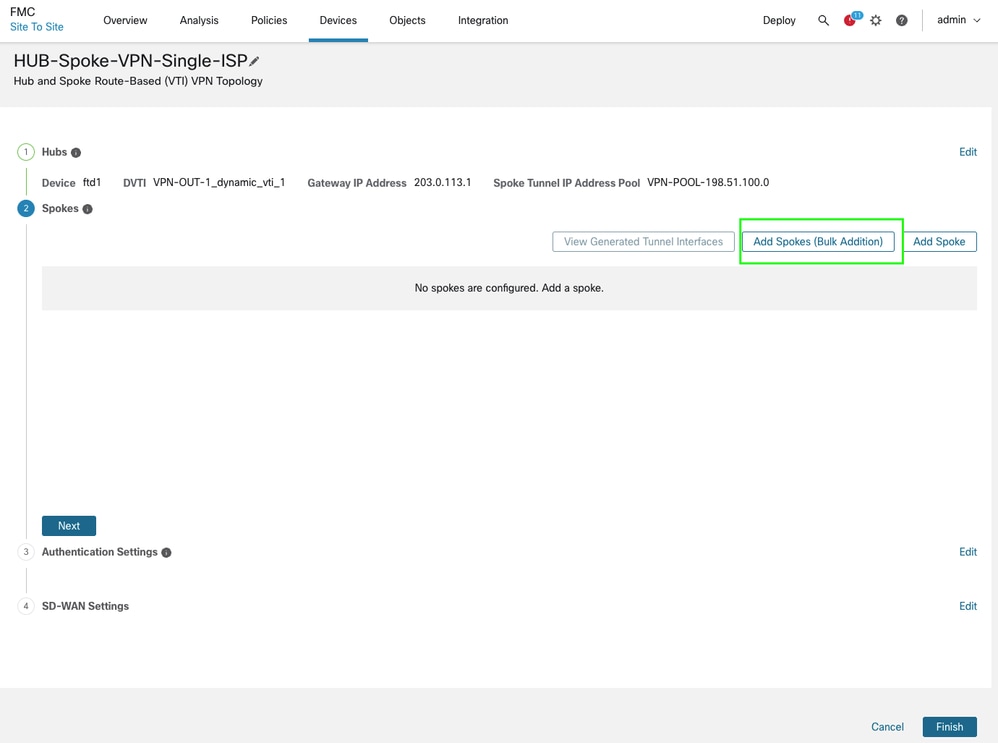
-
选择设备并指定WAN/外部接口的命名模式。如果设备共享相同的接口名称,使用首字母就足够了。单击Next,如果验证成功,则单击Add。对于批量添加,您也可以以相同的方式使用区域名称。
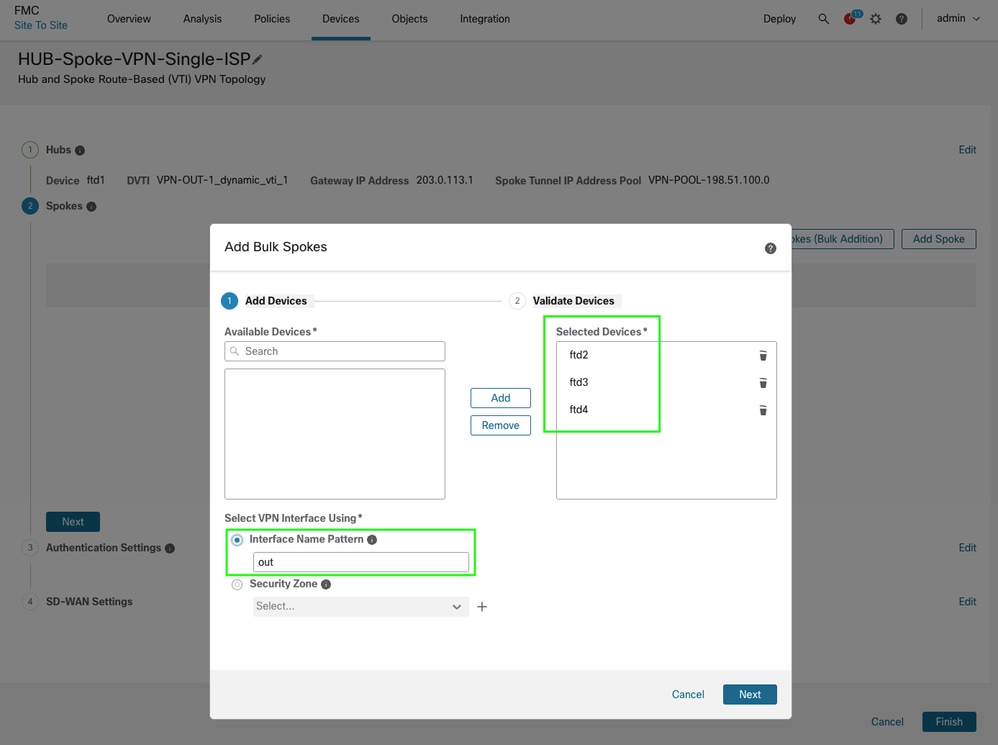
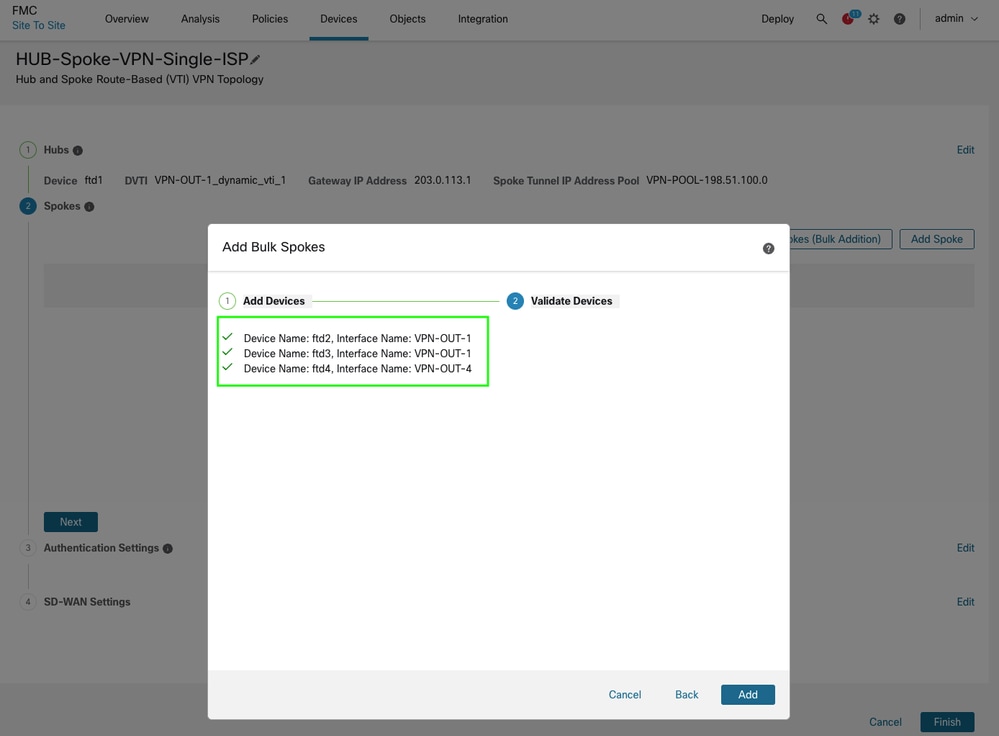
-
验证分支和重叠接口详细信息以确保选择了正确的接口,然后单击Next。
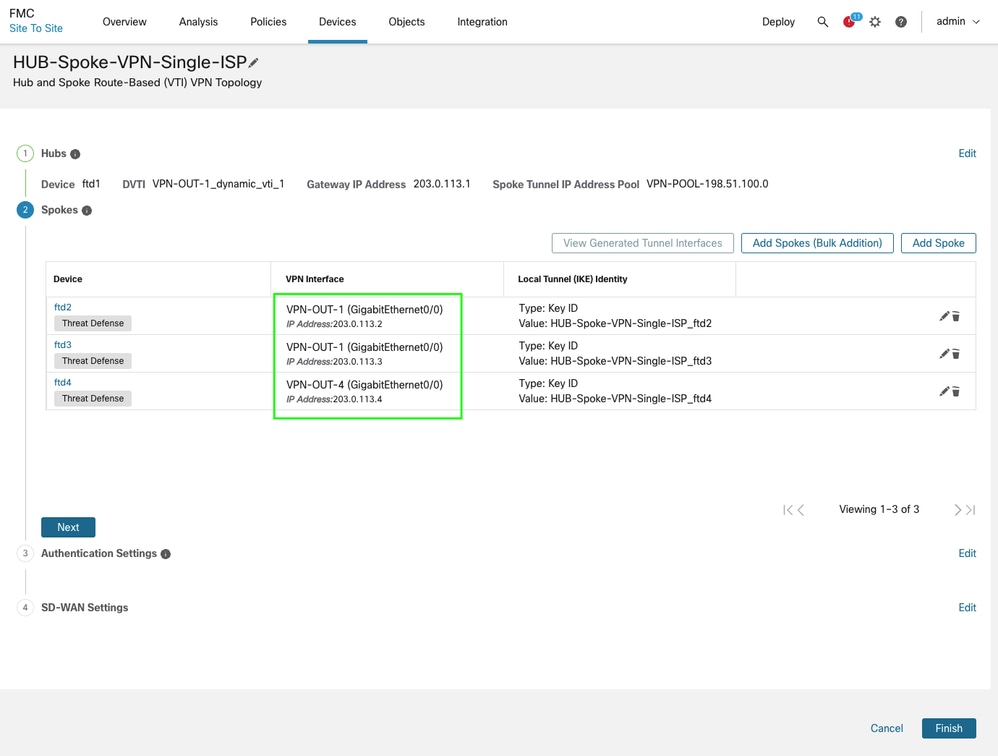
-
您可以保留IPsec配置的默认参数,也可以根据需要指定自定义密码。单击 Next(下一步)继续。在本文档中,您使用的是默认参数。
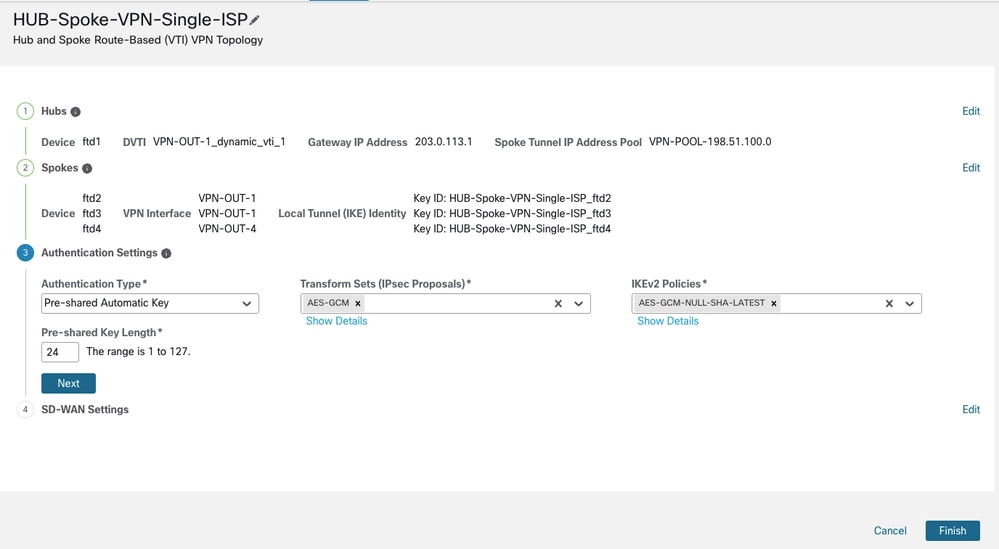
-
最后,可以通过指定适当的BGP参数(例如,用于前缀过滤的AS编号、内部接口通告和社区标记),在此拓扑的同一向导内配置重叠路由。安全区域可以通过访问控制策略协助流量过滤,同时您也可以为接口创建一个对象,并在连接的接口重分配中使用它们(如果名称与拓扑中的内部名称不同或不跨拓扑中的设备对称)。
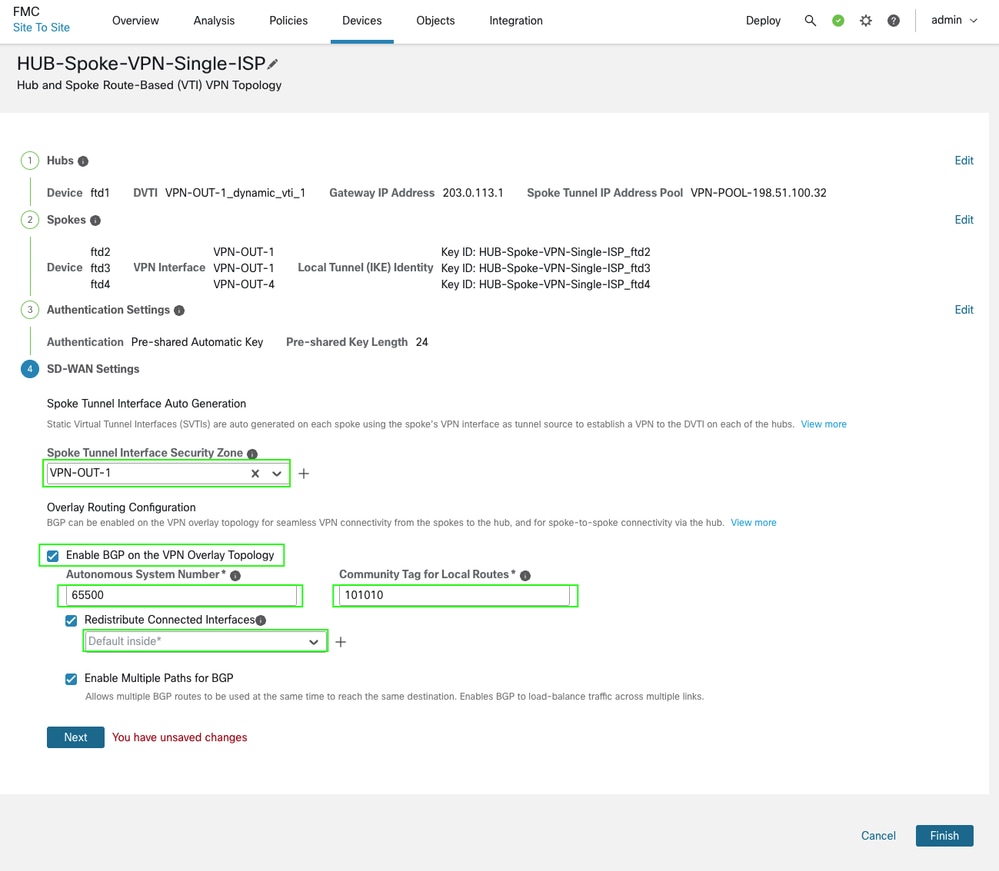
-
单击Next,然后单击Finish,最后单击Deploy完成此过程。
确认
-
您可以通过导航到Devices > VPN > Site to Site来验证隧道状态。

-
通过导航到概述>控制面板>站点到站点VPN,可以验证其他详细信息。

-
要获得进一步的见解,请选择隧道,然后单击查看完整信息。


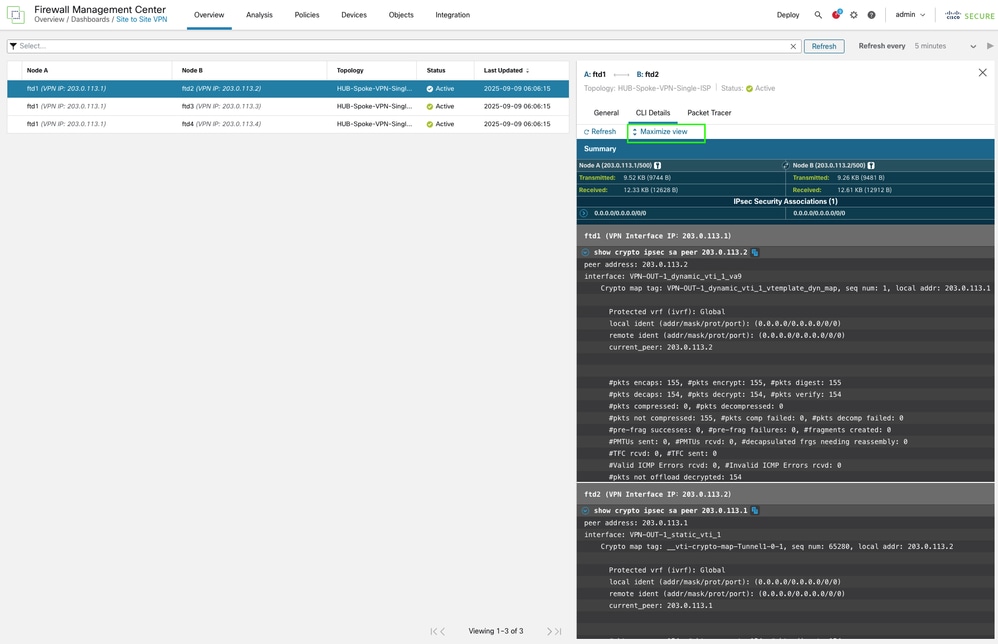
-
输出直接从FTD CLI显示,可以刷新以显示更新的计数器和重要信息,如安全参数索引(SPI)详细信息。
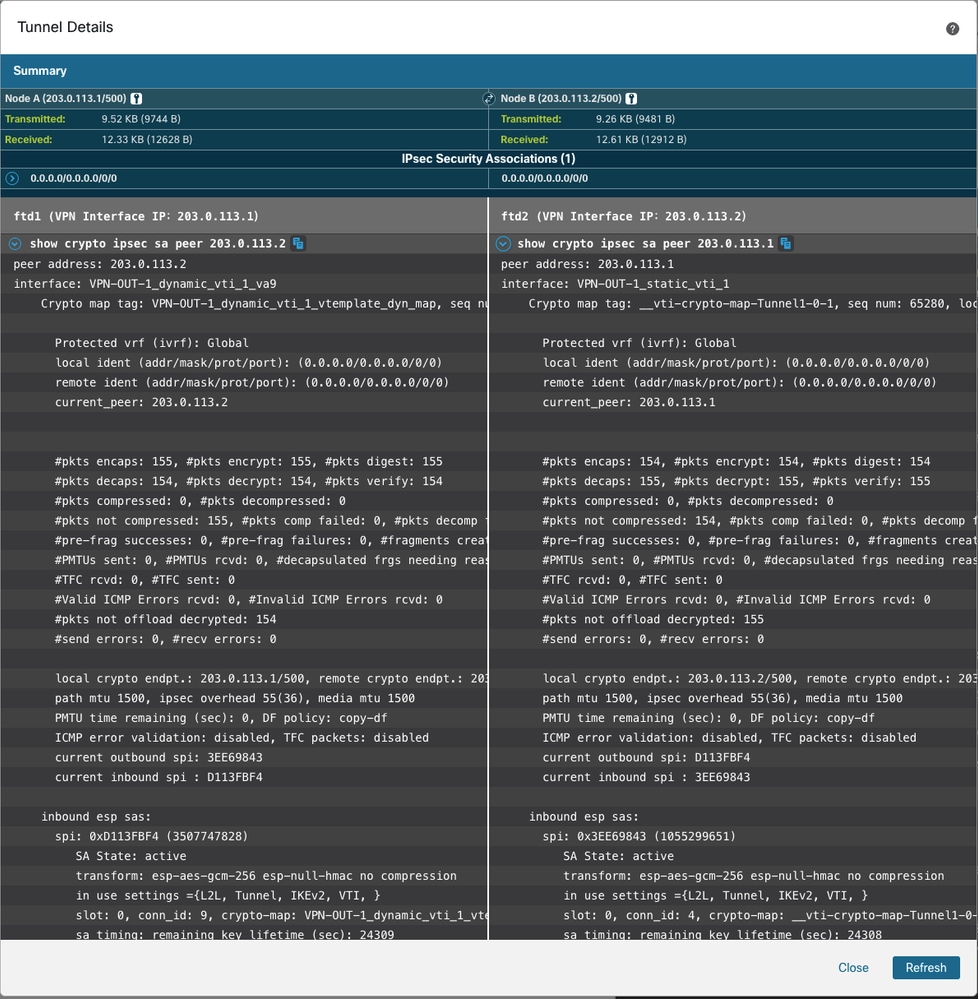
-
FTD CLI还可用于检查路由信息和BGP对等状态。
在集线器端
HUB1# show bgp summary BGP router identifier 198.51.100.3, local AS number 65500 BGP table version is 7, main routing table version 7 2 network entries using 400 bytes of memory 2 path entries using 160 bytes of memory 1/1 BGP path/bestpath attribute entries using 208 bytes of memory 1 BGP community entries using 24 bytes of memory 1 BGP route-map cache entries using 64 bytes of memory 0 BGP filter-list cache entries using 0 bytes of memory BGP using 856 total bytes of memory BGP activity 2/0 prefixes, 4/2 paths, scan interval 60 secs Neighbor V AS MsgRcvd MsgSent TblVer InQ OutQ Up/Down State/PfxRcd 198.51.100.10 4 65500 4 6 7 0 0 00:00:45 0 <<<<< spoke 1 bgp peering 198.51.100.11 4 65500 5 5 7 0 0 00:00:44 1 <<<<< spoke 2 bgp peering 198.51.100.12 4 65500 5 5 7 0 0 00:00:52 1 <<<<< spoke 3 bgp peering
HUB1# show route bgp
Codes: L - local, C - connected, S - static, R - RIP, M - mobile, B - BGP
D - EIGRP, EX - EIGRP external, O - OSPF, IA - OSPF inter area
N1 - OSPF NSSA external type 1, N2 - OSPF NSSA external type 2
E1 - OSPF external type 1, E2 - OSPF external type 2, V - VPN
i - IS-IS, su - IS-IS summary, L1 - IS-IS level-1, L2 - IS-IS level-2
ia - IS-IS inter area, * - candidate default, U - per-user static route
o - ODR, P - periodic downloaded static route, + - replicated route
SI - Static InterVRF, BI - BGP InterVRF
Gateway of last resort is not set
B 192.0.2.0 255.255.255.248 [200/1] via 198.51.100.10, 00:00:18 <<<<<<<< spoke 1 inside network
B 192.0.2.8 255.255.255.248 [200/1] via 198.51.100.11, 00:08:08 <<<<<<<< spoke 2 inside network
B 192.0.2.16 255.255.255.248 [200/1] via 198.51.100.12, 00:08:16 <<<<<<<< spoke 3 inside networkHUB1#show bgp ipv4 unicast neighbors 198.51.100.10 routes <<<<< to check only prefix receieved from specific peer
BGP table version is 14, local router ID is 198.51.100.3
Status codes: s suppressed, d damped, h history, * valid, > best, i - internal,
r RIB-failure, S Stale, m multipath
Origin codes: i - IGP, e - EGP, ? - incomplete
Network Next Hop Metric LocPrf Weight Path
*>i192.0.2.0/29 198.51.100.10 1 100 0 ? <<<<<<<<<< routes received from spoke 1
Total number of prefixes 1HUB1#show bgp ipv4 unicast neighbors 198.51.100.11 routes <<<<< to check only prefix receieved from specific peer
BGP table version is 14, local router ID is 198.51.100.3 Status codes: s suppressed, d damped, h history, * valid, > best, i - internal, r RIB-failure, S Stale, m multipath Origin codes: i - IGP, e - EGP, ? - incomplete Network Next Hop Metric LocPrf Weight Path *>i192.0.2.8/29 198.51.100.11 1 100 0 ? <<<<<<<<<< routes received from spoke 2 Total number of prefixes 1
HUB1#show bgp ipv4 unicast neighbors 198.51.100.12 routes <<<<< to check only prefix receieved from specific peer
BGP table version is 14, local router ID is 198.51.100.3 Status codes: s suppressed, d damped, h history, * valid, > best, i - internal, r RIB-failure, S Stale, m multipath Origin codes: i - IGP, e - EGP, ? - incomplete Network Next Hop Metric LocPrf Weight Path *>i192.0.2.16/29 198.51.100.12 1 100 0 ? <<<<<<<<<< routes received from spoke 3 Total number of prefixes 1
在辐射端
也可以在分支设备上执行相同的验证。以下是一个辐条示例。
Spoke1# show bgp summary BGP router identifier 198.51.100.4, local AS number 65500 BGP table version is 12, main routing table version 12 3 network entries using 600 bytes of memory 3 path entries using 240 bytes of memory 2/2 BGP path/bestpath attribute entries using 416 bytes of memory 2 BGP rrinfo entries using 80 bytes of memory 1 BGP community entries using 24 bytes of memory 0 BGP route-map cache entries using 0 bytes of memory 0 BGP filter-list cache entries using 0 bytes of memory BGP using 1360 total bytes of memory BGP activity 5/2 prefixes, 7/4 paths, scan interval 60 secs Neighbor V AS MsgRcvd MsgSent TblVer InQ OutQ Up/Down State/PfxRcd 198.51.100.1 4 65500 12 11 12 0 0 00:07:11 2 <<<<<<<<< BGP peering with HUB
Spoke1# show bgp ipv4 unicast neighbors 198.51.100.1 routes
BGP table version is 12, local router ID is 198.51.100.4
Status codes: s suppressed, d damped, h history, * valid, > best, i - internal,
r RIB-failure, S Stale, m multipath
Origin codes: i - IGP, e - EGP, ? - incomplete
Network Next Hop Metric LocPrf Weight Path
*>i192.0.2.8/29 198.51.100.1 1 100 0 ? <<<<<<< route received from HUB for spoke 2
*>i192.0.2.16/29 198.51.100.1 1 100 0 ? <<<<<<< route received from HUB for spoke 3
Total number of prefixes 2 Spoke1# show bgp ipv4 unicast neighbors 198.51.100.1 advertised-routes
BGP table version is 12, local router ID is 198.51.100.4
Status codes: s suppressed, d damped, h history, * valid, > best, i - internal,
r RIB-failure, S Stale, m multipath
Origin codes: i - IGP, e - EGP, ? - incomplete
Network Next Hop Metric LocPrf Weight Path
*> 192.0.2.0/29 0.0.0.0 0 32768 ? <<<<<<<< route advertised by this spoke into BGP
Total number of prefixes 1 Spoke1# show route bgp
Codes: L - local, C - connected, S - static, R - RIP, M - mobile, B - BGP
D - EIGRP, EX - EIGRP external, O - OSPF, IA - OSPF inter area
N1 - OSPF NSSA external type 1, N2 - OSPF NSSA external type 2
E1 - OSPF external type 1, E2 - OSPF external type 2, V - VPN
i - IS-IS, su - IS-IS summary, L1 - IS-IS level-1, L2 - IS-IS level-2
ia - IS-IS inter area, * - candidate default, U - per-user static route
o - ODR, P - periodic downloaded static route, + - replicated route
SI - Static InterVRF, BI - BGP InterVRF
Gateway of last resort is not set
B 192.0.2.8 255.255.255.248 [200/1] via 198.51.100.1, 00:13:42 <<<<<< spoke 2 inside network
B 192.0.2.16 255.255.255.248 [200/1] via 198.51.100.1, 00:13:42 <<<<<< spoke 3 inside network双中心辐射型(通过辅助中心辐射和辐射之间的EBGP为冗余中心提供单一ISP)
网络图
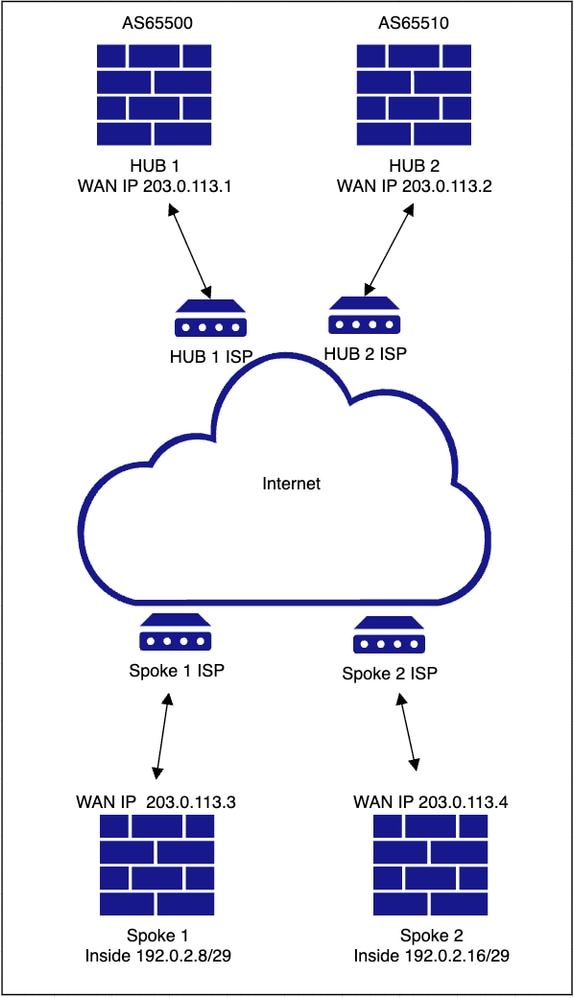
配置
同一向导是必需的,在HUB添加窗口中进行了细微修改。您只需关注必要的更改,即可快速推进流程。
·添加第一个HUB后,使用与HUB1相同的步骤继续添加第二个HUB。
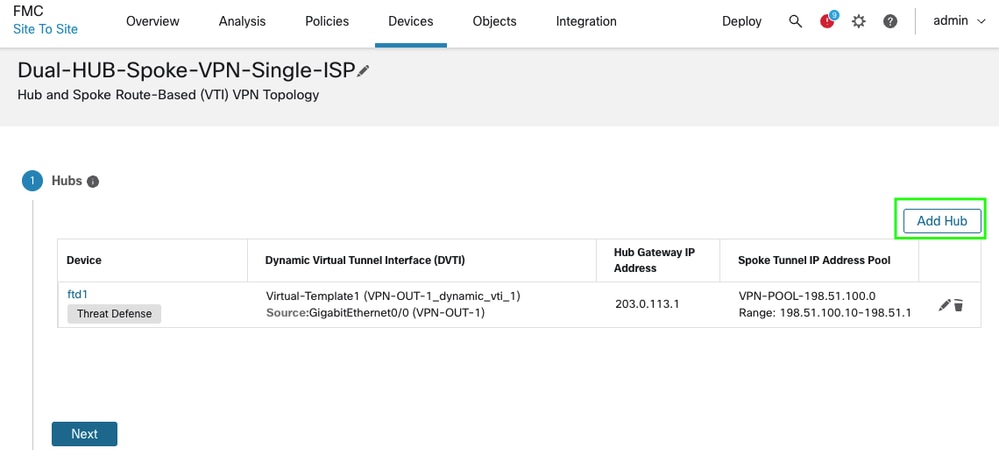
-
继续创建动态虚拟隧道接口(DVTI)。
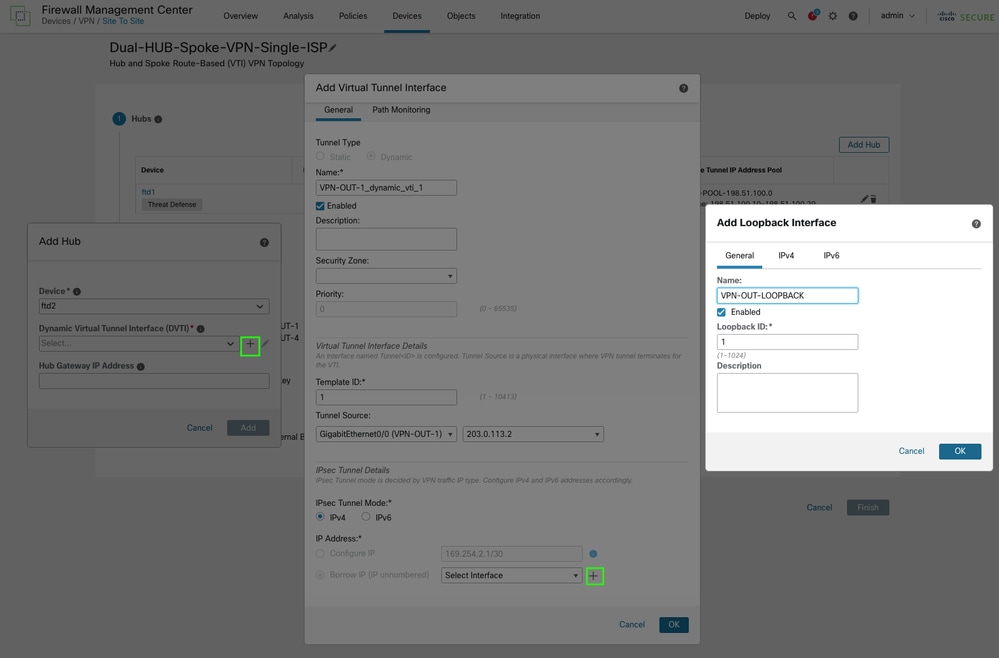
-
分支端上的集线器2 VTI隧道需要新的IP地址池。创建并配置新池,然后保存更改。
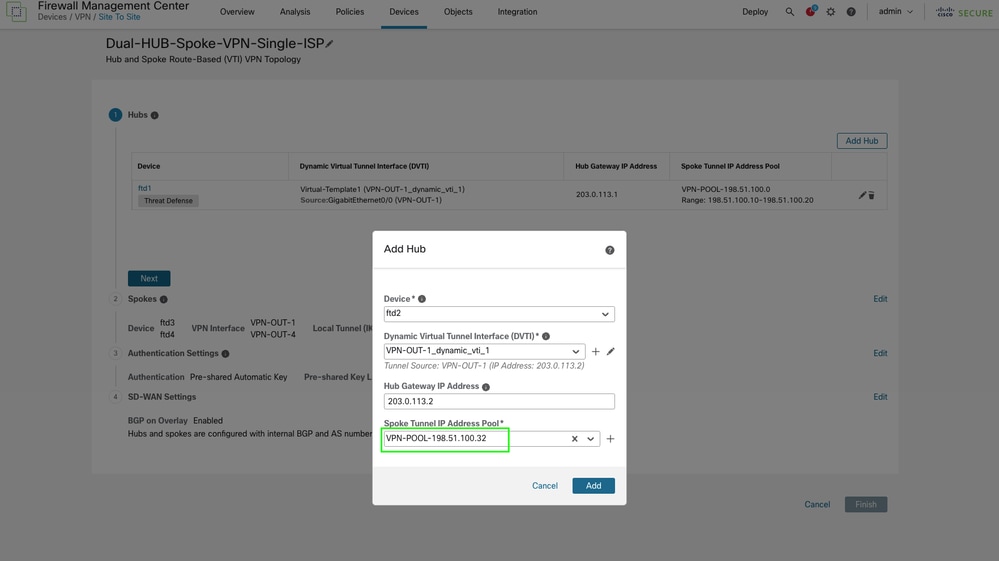
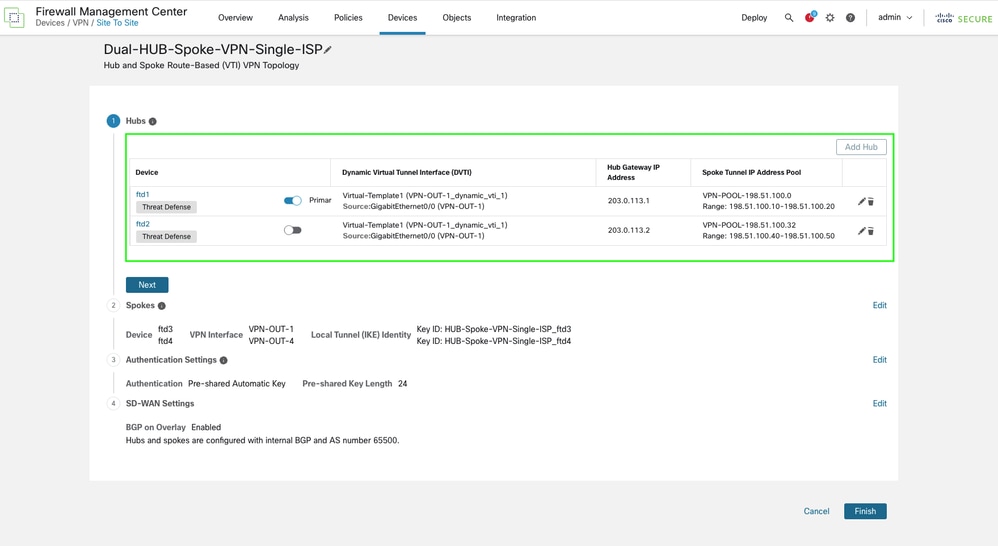
-
要在第二个HUB和辐射点之间配置eBGP对等,请在最后一步中修改SD-WAN设置。启用选项Secondary HUB is in a different Autonomous System,并指定辅助HUB的自治系统(AS)编号。如果通过取消选中Secondary HUB is in a different Autonomous System选项,在环境中使用不同AS编号没有限制,则也可以使用IBGP。这也会推送辅助HUB的相同社区标记和AS编号。本文重点介绍当前设置的eBGP。
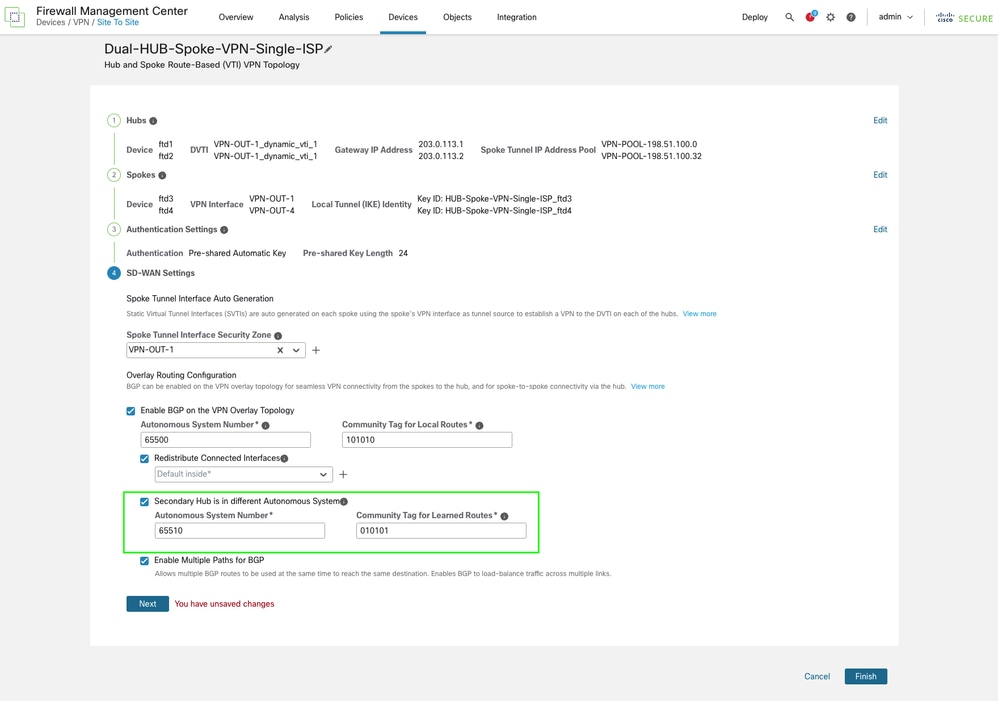
确保自治系统(AS)编号和社区标记在此配置中是唯一的。
确认
下图说明了重叠拓扑。
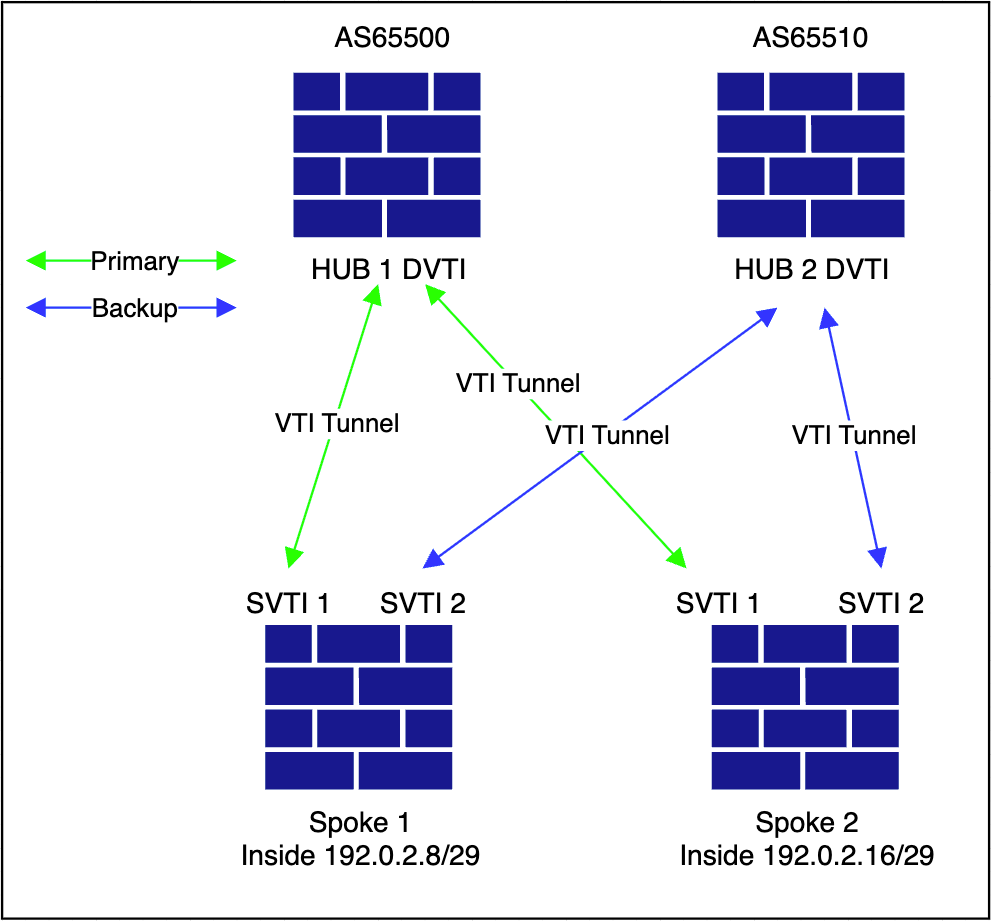
-
在FMC中,导航到设备 > VPN > 站点到站点。

-
所有其他步骤保持不变。
双中心辐射型(双ISP通过辅助中心辐射型和辐射型之间的EBGP提供冗余中心和ISP)
网络图
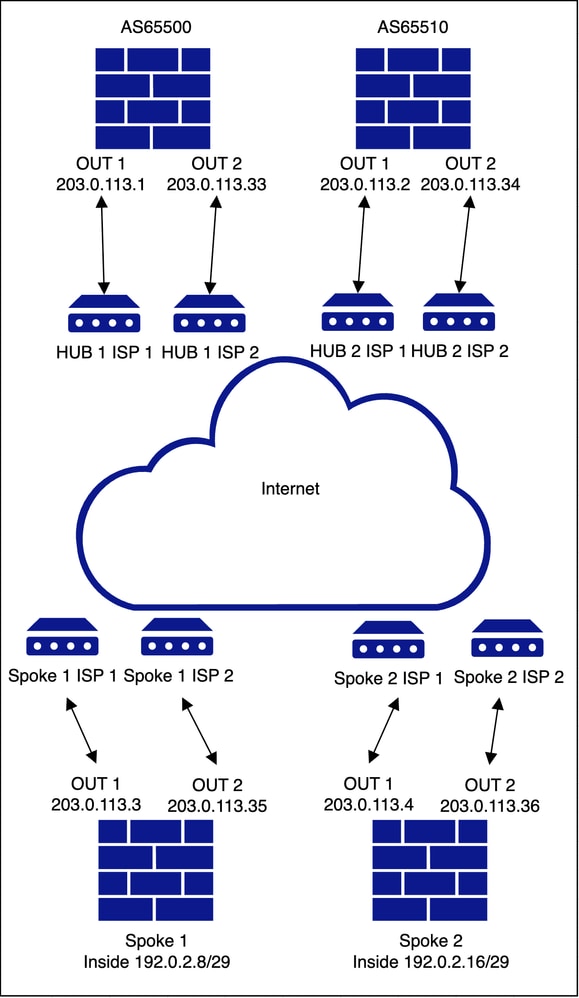
配置
此场景的唯一区别是配置了两个单独的SD-WAN拓扑,每个拓扑都使用其各自的ISP接口作为基础。
·使用第一个ISP跳过此拓扑的部署。因为上一拓扑中涉及了此拓扑。

-
接下来,继续添加第二个拓扑,为每台集线器创建两个额外的DVTI接口,每个接口使用ISP 2的底层接口(VPN-OUT-2)。
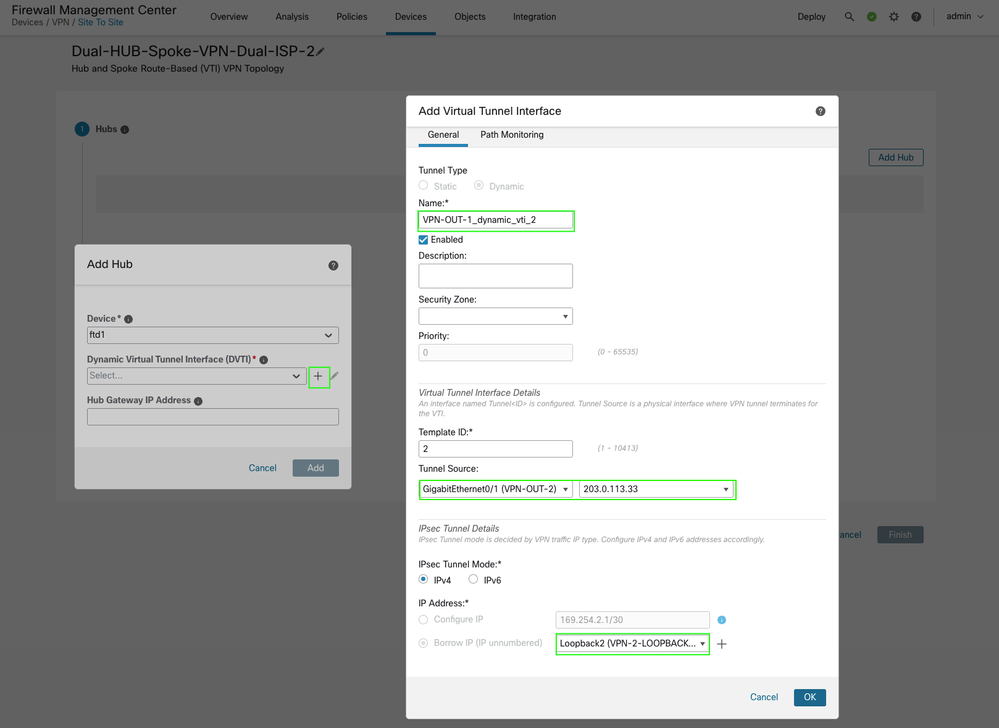
-
专门为分支虚拟隧道接口(VTI)地址调配了额外的VPN IP地址池。
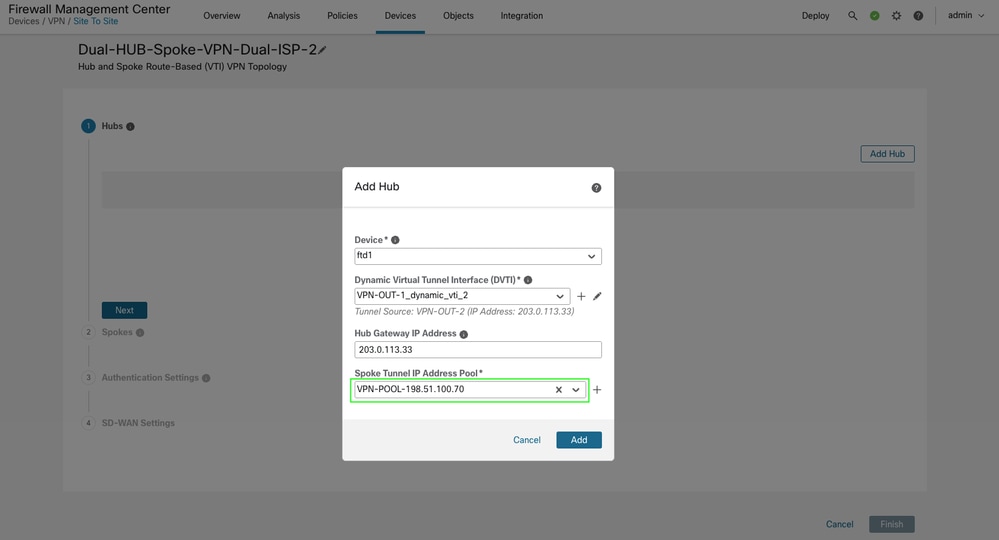
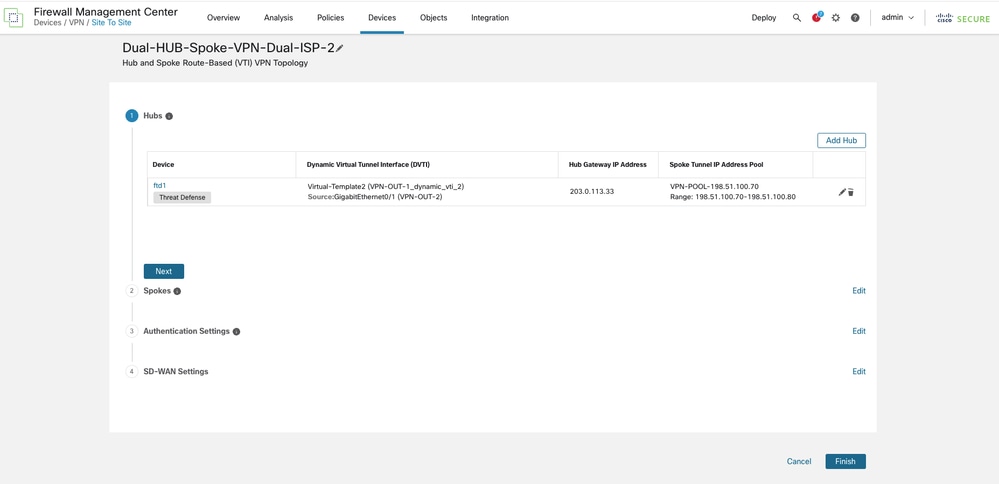
-
要添加辅助集线器,请使用辅助ISP接口(VPN-OUT-2)创建DVTI 2重复此过程,并为辐射端VTI地址配置一个额外的IP池。
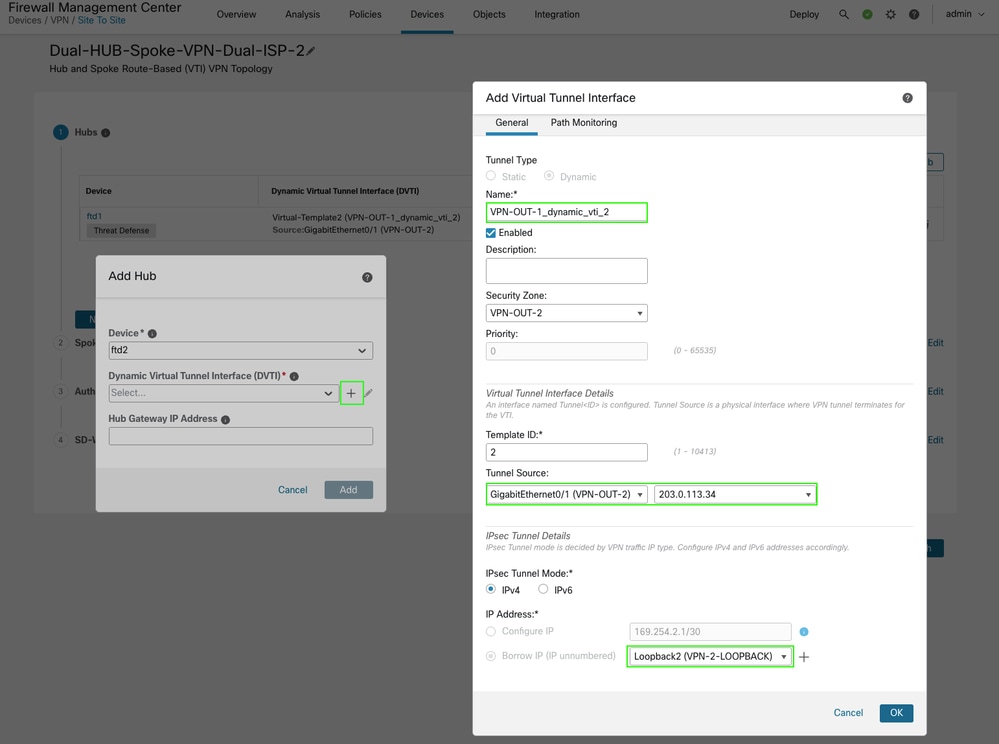
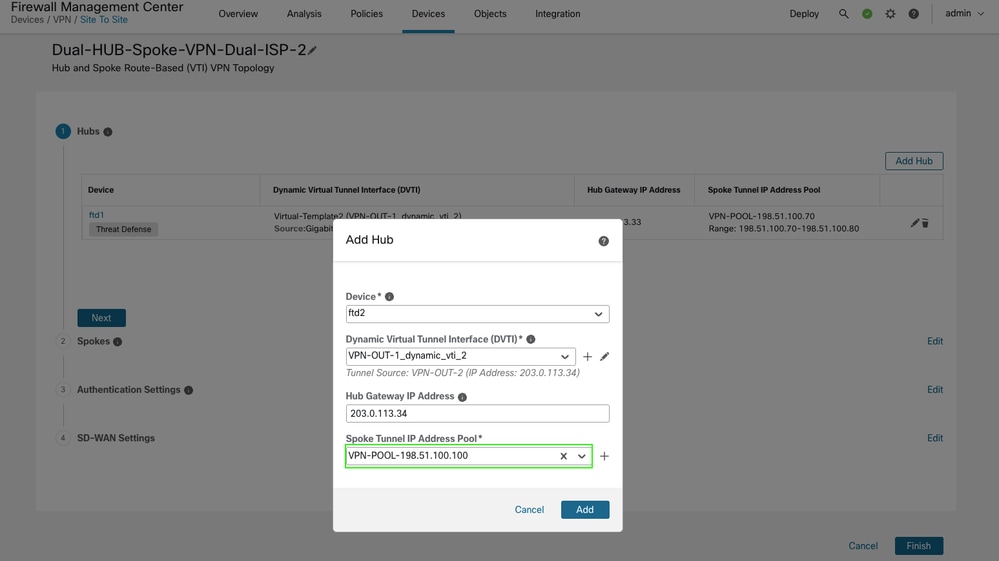
-
添加辐条时,请确保为VTI隧道指定正确的底层/WAN接口。此拓扑使用辅助ISP接口VPN-OUT-2。
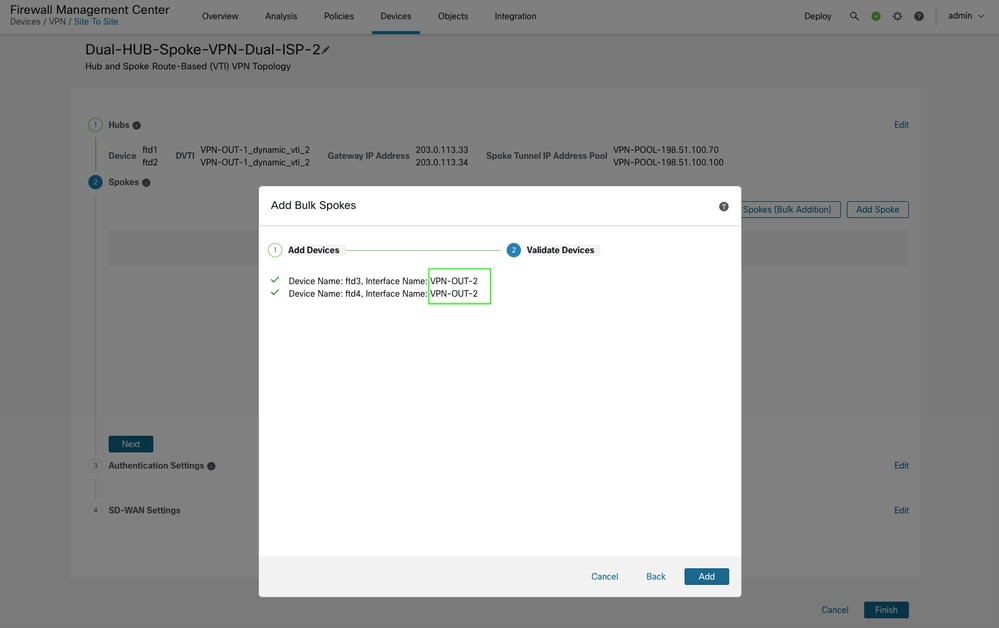
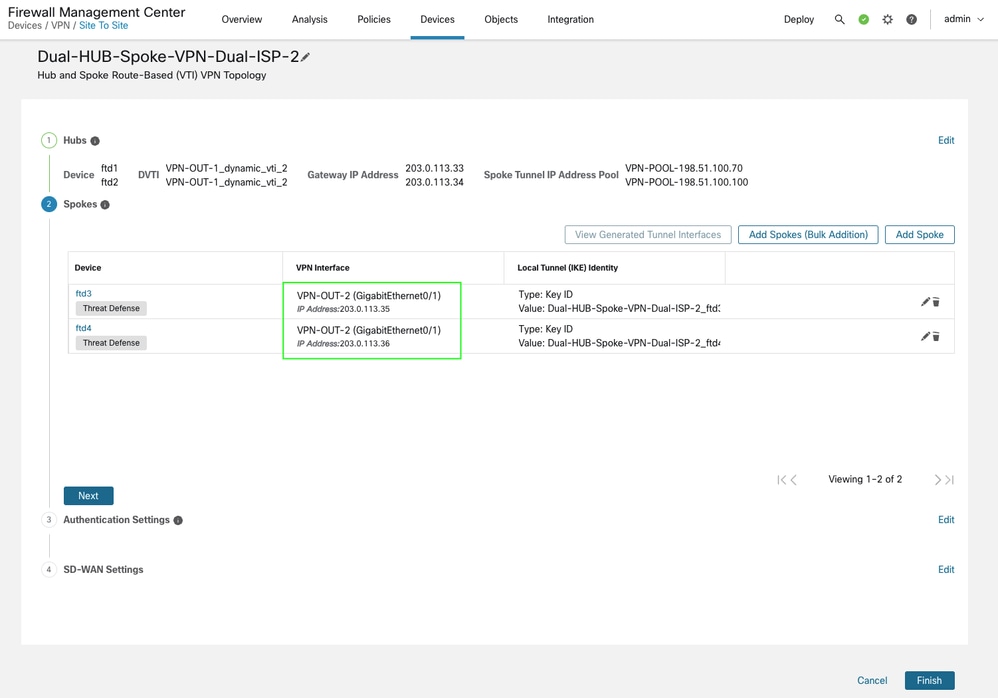
-
配置路由时,请确保此拓扑中两个HUB的团体标记和AS编号与之前的ISP1拓扑中所使用的标记和AS编号一致。拓扑使用不同的安全区域,但其他配置(如主要和辅助HUB的AS编号以及社区标记)是相同的。UI必须执行此操作才能完成拓扑验证。
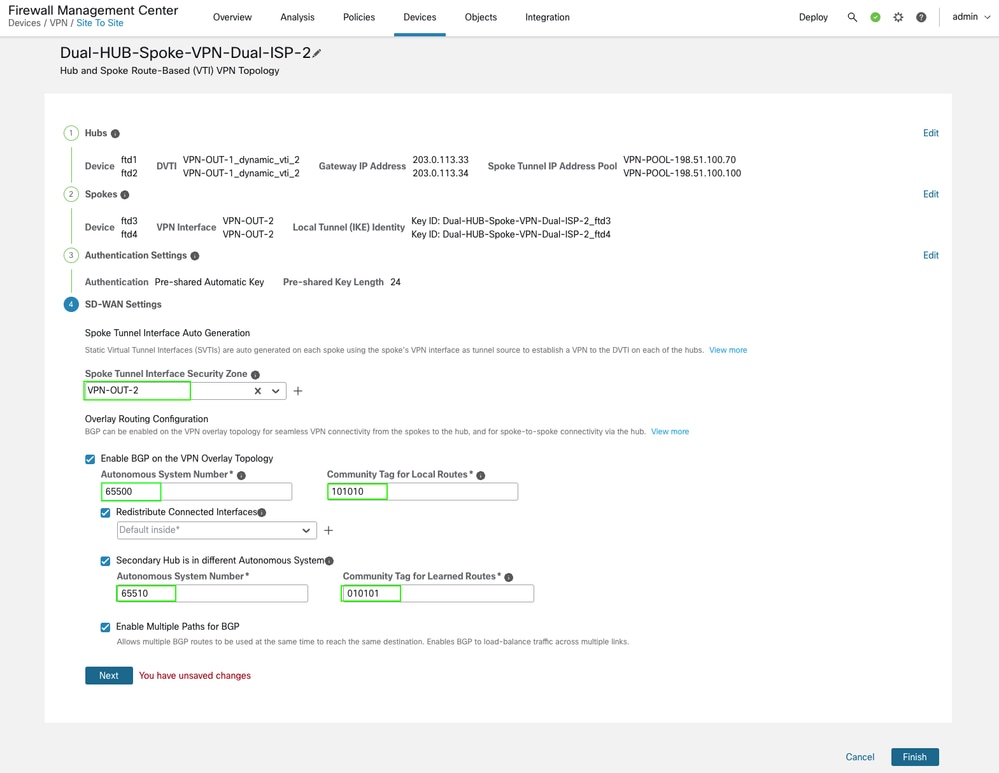
-
所有其他设置保持不变。完成向导并继续部署。
确认
-
拓扑如图所示。
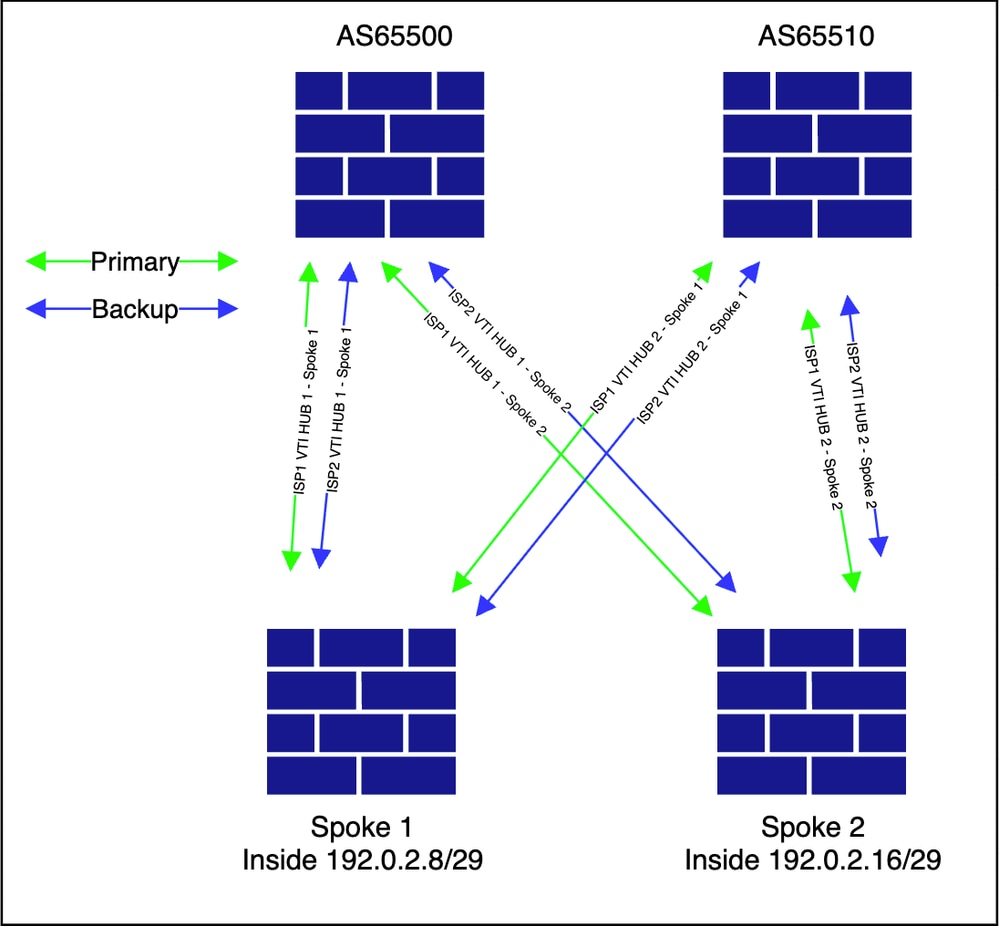
-
导航到设备(Devices)> VPN >站点到站点(Site to Site)以查看拓扑。
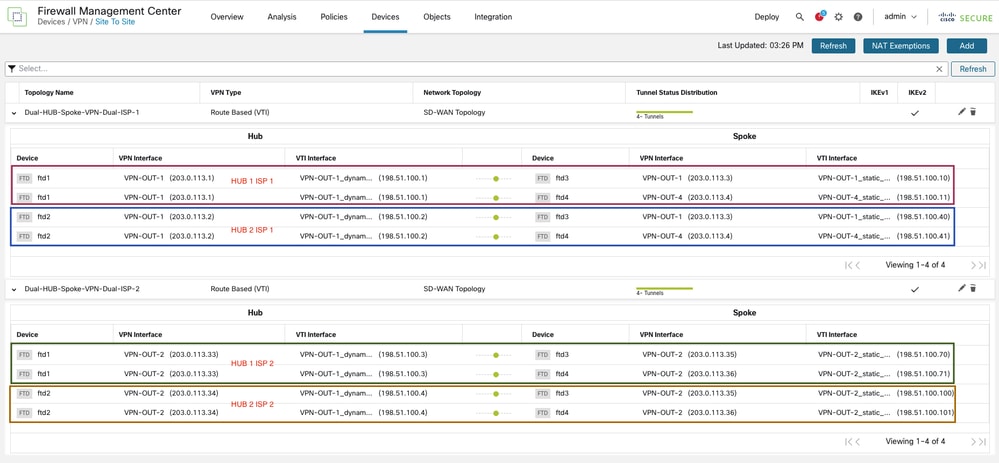
此配置导致每个设备有四个BGP对等,并且每个分支都有到达其他分支的适当路由。例如,您可以检索其中一个分支的输出。
对于分支1
Spoke1#show bgp summary BGP router identifier 203.0.113.35, local AS number 65500 BGP table version is 4, main routing table version 4 2 network entries using 400 bytes of memory 7 path entries using 560 bytes of memory 1 multipath network entries and 2 multipath paths 3/2 BGP path/bestpath attribute entries using 624 bytes of memory 1 BGP rrinfo entries using 40 bytes of memory 1 BGP AS-PATH entries using 40 bytes of memory 2 BGP community entries using 48 bytes of memory 0 BGP route-map cache entries using 0 bytes of memory 0 BGP filter-list cache entries using 0 bytes of memory BGP using 1712 total bytes of memory BGP activity 2/0 prefixes, 7/0 paths, scan interval 60 secs Neighbor V AS MsgRcvd MsgSent TblVer InQ OutQ Up/Down State/PfxRcd 198.51.100.1 4 65500 229 226 4 0 0 04:07:22 1 <<<<<<<<<< HUB 1 ISP 1 VTI 198.51.100.2 4 65510 226 230 4 0 0 04:06:36 2 <<<<<<<<<< HUB 2 ISP 1 VTI 198.51.100.3 4 65500 182 183 4 0 0 03:16:45 1 <<<<<<<<<< HUB 1 ISP 2 VTI 198.51.100.4 4 65510 183 183 4 0 0 03:16:30 2 <<<<<<<<<< HUB 2 ISP 2 VTI
Spoke1#show bgp ipv4 unicast neighbors 198.51.100.1 routes <<<< check for specific prefixes received via HUB1 ISP1
BGP table version is 4, local router ID is 203.0.113.35
Status codes: s suppressed, d damped, h history, * valid, > best, i - internal,
r RIB-failure, S Stale, m multipath
Origin codes: i - IGP, e - EGP, ? - incomplete
Network Next Hop Metric LocPrf Weight Path
*>i192.0.2.16/29 198.51.100.1 1 100 0 ? <<<<<<<< spoke 2 network received via HUB 1 ISP 1 tunnel
Total number of prefixes 1 Spoke1#show bgp ipv4 unicast neighbors 198.51.100.3 routes <<<< check for specific prefixes received via HUB1 ISP2
BGP table version is 4, local router ID is 203.0.113.35
Status codes: s suppressed, d damped, h history, * valid, > best, i - internal,
r RIB-failure, S Stale, m multipath
Origin codes: i - IGP, e - EGP, ? - incomplete
Network Next Hop Metric LocPrf Weight Path
*mi192.0.2.16/29 198.51.100.3 1 100 0 ? <<<<<<<< spoke 2 network received via HUB 1 ISP 2 tunnel
Total number of prefixes 1 Spoke1# show bgp ipv4 unicast neighbors 198.51.100.2 routes <<<< check for specific prefixes received via HUB2 ISP1
BGP table version is 4, local router ID is 203.0.113.35 Status codes: s suppressed, d damped, h history, * valid, > best, i - internal, r RIB-failure, S Stale, m multipath Origin codes: i - IGP, e - EGP, ? - incomplete Network Next Hop Metric LocPrf Weight Path * 192.0.2.8/29 198.51.100.2 100 0 65510 65510 ? <<<<<<< inside network receieved cause we advertised it to HUB 1 from ISP 2 topology * 192.0.2.16/29 198.51.100.2 100 0 65510 65510 ? <<<<<<<< spoke 2 network received via HUB 2 ISP 1 tunnel but not preferred Total number of prefixes 2
Spoke1# show bgp ipv4 unicast neighbors 198.51.100.4 routes <<<< check for specific prefixes received via HUB2 ISP1
BGP table version is 4, local router ID is 203.0.113.35 Status codes: s suppressed, d damped, h history, * valid, > best, i - internal, r RIB-failure, S Stale, m multipath Origin codes: i - IGP, e - EGP, ? - incomplete Network Next Hop Metric LocPrf Weight Path * 192.0.2.8/29 198.51.100.4 100 0 65510 65510 ? <<<<<<< inside network receieved cause we advertised it to HUB 2 from ISP 1 topology * 192.0.2.16/29 198.51.100.4 100 0 65510 65510 ? <<<<<<<< spoke 2 network received via HUB 2 ISP 2 tunnel but not preferred Total number of prefixes 2
路由表如图所示,它确认分支端两个链路之间的流量已实现负载均衡。
Spoke1#show route bgp
Codes: L - local, C - connected, S - static, R - RIP, M - mobile, B - BGP
D - EIGRP, EX - EIGRP external, O - OSPF, IA - OSPF inter area
N1 - OSPF NSSA external type 1, N2 - OSPF NSSA external type 2
E1 - OSPF external type 1, E2 - OSPF external type 2, V - VPN
i - IS-IS, su - IS-IS summary, L1 - IS-IS level-1, L2 - IS-IS level-2
ia - IS-IS inter area, * - candidate default, U - per-user static route
o - ODR, P - periodic downloaded static route, + - replicated route
SI - Static InterVRF, BI - BGP InterVRF
Gateway of last resort is not set
B 192.0.2.16 255.255.255.248 [200/1] via 198.51.100.3, 03:23:53 <<<<< multipath for spoke 2 inside network
[200/1] via 198.51.100.1, 03:23:53 <<<<< multipath for spoke 2 inside networkSpoke1#show bgp 192.0.2.16
BGP routing table entry for 192.0.2.16/29, version 4
Paths: (4 available, best #4, table default)
Multipath: eBGP iBGP
Advertised to update-groups:
2 4
65510 65510
198.51.100.4 from 198.51.100.4 (198.51.100.4) <<<< HUB2 ISP2 next-hop
Origin incomplete, metric 100, localpref 100, valid, external
Community: 10101
Local
198.51.100.3 from 198.51.100.3 (198.51.100.3) <<<< HUB1 ISP2 next-hop
Origin incomplete, metric 1, localpref 100, valid, internal, multipath
Community: 10101
Originator: 203.0.113.36, Cluster list: 198.51.100.3
65510 65510
198.51.100.2 from 198.51.100.2 (198.51.100.4) <<<< HUB2 ISP1 next-hop
Origin incomplete, metric 100, localpref 100, valid, external
Community: 10101
Local
198.51.100.1 from 198.51.100.1 (198.51.100.3) <<<< HUB1 ISP1 next-hop
Origin incomplete, metric 1, localpref 100, valid, internal, multipath, best
Community: 10101
Originator: 203.0.113.36, Cluster list: 198.51.100.3结论
本文的目的是解释可以使用单个设置向导轻松实施的各种部署方案。
相关信息
修订历史记录
| 版本 | 发布日期 | 备注 |
|---|---|---|
1.0 |
01-Oct-2025
|
初始版本 |
由思科工程师提供
- 达尼亚尔·阿赫塔尔技术咨询工程师
 反馈
反馈